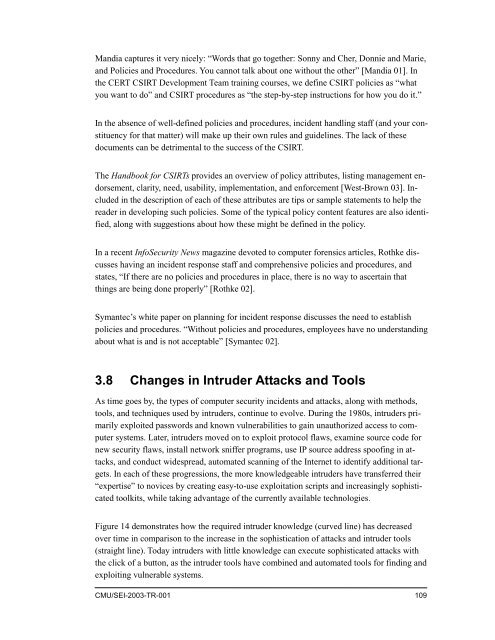State of the Practice of Computer Security Incident Response Teams ...
State of the Practice of Computer Security Incident Response Teams ...
State of the Practice of Computer Security Incident Response Teams ...
Create successful ePaper yourself
Turn your PDF publications into a flip-book with our unique Google optimized e-Paper software.
Mandia captures it very nicely: “Words that go toge<strong>the</strong>r: Sonny and Cher, Donnie and Marie,<br />
and Policies and Procedures. You cannot talk about one without <strong>the</strong> o<strong>the</strong>r” [Mandia 01]. In<br />
<strong>the</strong> CERT CSIRT Development Team training courses, we define CSIRT policies as “what<br />
you want to do” and CSIRT procedures as “<strong>the</strong> step-by-step instructions for how you do it.”<br />
In <strong>the</strong> absence <strong>of</strong> well-defined policies and procedures, incident handling staff (and your constituency<br />
for that matter) will make up <strong>the</strong>ir own rules and guidelines. The lack <strong>of</strong> <strong>the</strong>se<br />
documents can be detrimental to <strong>the</strong> success <strong>of</strong> <strong>the</strong> CSIRT.<br />
The Handbook for CSIRTs provides an overview <strong>of</strong> policy attributes, listing management endorsement,<br />
clarity, need, usability, implementation, and enforcement [West-Brown 03]. Included<br />
in <strong>the</strong> description <strong>of</strong> each <strong>of</strong> <strong>the</strong>se attributes are tips or sample statements to help <strong>the</strong><br />
reader in developing such policies. Some <strong>of</strong> <strong>the</strong> typical policy content features are also identified,<br />
along with suggestions about how <strong>the</strong>se might be defined in <strong>the</strong> policy.<br />
In a recent Info<strong>Security</strong> News magazine devoted to computer forensics articles, Rothke discusses<br />
having an incident response staff and comprehensive policies and procedures, and<br />
states, “If <strong>the</strong>re are no policies and procedures in place, <strong>the</strong>re is no way to ascertain that<br />
things are being done properly” [Rothke 02].<br />
Symantec’s white paper on planning for incident response discusses <strong>the</strong> need to establish<br />
policies and procedures. “Without policies and procedures, employees have no understanding<br />
about what is and is not acceptable” [Symantec 02].<br />
3.8 Changes in Intruder Attacks and Tools<br />
As time goes by, <strong>the</strong> types <strong>of</strong> computer security incidents and attacks, along with methods,<br />
tools, and techniques used by intruders, continue to evolve. During <strong>the</strong> 1980s, intruders primarily<br />
exploited passwords and known vulnerabilities to gain unauthorized access to computer<br />
systems. Later, intruders moved on to exploit protocol flaws, examine source code for<br />
new security flaws, install network sniffer programs, use IP source address spo<strong>of</strong>ing in attacks,<br />
and conduct widespread, automated scanning <strong>of</strong> <strong>the</strong> Internet to identify additional targets.<br />
In each <strong>of</strong> <strong>the</strong>se progressions, <strong>the</strong> more knowledgeable intruders have transferred <strong>the</strong>ir<br />
“expertise” to novices by creating easy-to-use exploitation scripts and increasingly sophisticated<br />
toolkits, while taking advantage <strong>of</strong> <strong>the</strong> currently available technologies.<br />
Figure 14 demonstrates how <strong>the</strong> required intruder knowledge (curved line) has decreased<br />
over time in comparison to <strong>the</strong> increase in <strong>the</strong> sophistication <strong>of</strong> attacks and intruder tools<br />
(straight line). Today intruders with little knowledge can execute sophisticated attacks with<br />
<strong>the</strong> click <strong>of</strong> a button, as <strong>the</strong> intruder tools have combined and automated tools for finding and<br />
exploiting vulnerable systems.<br />
CMU/SEI-2003-TR-001 109
















